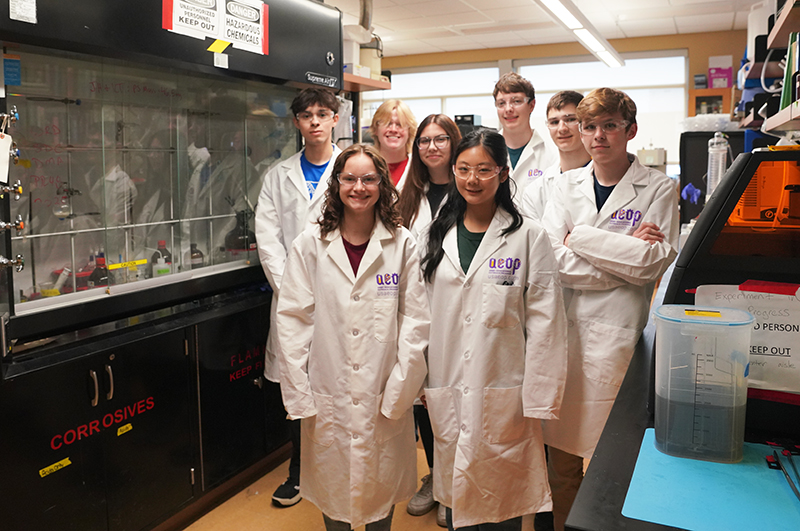High School Students Explore STEM Careers Through Research Program at South Dakota Mines

From micrometeorites to biomedical materials, high school students participating in the Army Educational Outreach Program (AEOP) at South Dakota Mines are gaining hands-on experience in cutting-edge STEM research.
This summer, students are working alongside undergraduate and graduate mentors on projects ranging from studying extraterrestrial particles and 3D printing with local minerals to recovering critical resources and developing biomedical technologies. With guidance from Mines faculty and student researchers, these aspiring scientists are exploring real-world challenges and building skills that will shape their future in STEM.
“This is a pretty prestigious program,” said Katrina Donovan, Ph.D., a senior lecturer in materials and metallurgical engineering and AEOP program director. “I had students from all over the United States applying to come to Mines.”
Donovan first discovered her passion for STEM as a high school student in rural South Dakota through a research opportunity with the National Institutes of Health —experiences she now helps create for others through AEOP, which connects high school and undergraduate students with hands-on research at universities and U.S. Army labs.
Mines has participated in the AEOP since 2012, with Donovan taking over leadership of the program in 2022. The program was originally led by Michael West, Ph.D., head of the Department of Materials and Metallurgical Engineering, who also served as the principal investigator on the initial AEOP grant and mentored Donovan in the role.
Mines is one of 14 research sites nationwide from which students can choose. Donovan had eight students this summer, each logging 200 hours during their summer research experience. Students work at their own pace and mostly in groups. More than 40 students applied to come to Mines through the program this summer.
"Being a student in the AEOP program at Mines has been an invaluable experience,” said Isabella Chow, who is entering her freshman year at Hofstra University in New York.
Chow and AEOP student Nadya Belcher, an incoming junior at Central High School, are working with Mines student Jonathan Brickey, a sophomore chemical engineering major and Accelerating Career Exploration (ACE) research student, and Laura Brunmaier, Ph.D., research assistant, on a NASA-sponsored biomedical project. “I have learned about the mechanics of polymers and how materials work in our world - from how the jelly beads in Orbitz float to developing new glazes to make clay stronger and more durable,” Chow said. “This has opened my eyes to the importance of understanding materials in order to develop new products to improve our world."
In their research, Chow and Belcher worked with sodium alginate and calcium chloride as a model system to develop tissue-engineered vascular grafts. “This way, if someone has a bad artery and needs a bypass, they can use the other biological model systems instead of veins from the legs,” Belcher said, adding that the experience helped her realize that failure is a big part of finding the right solutions. “Failure plays a big role in the research you do. After failure, you know that option won’t work, so you are already one step closer to succeeding,” she said.
Belcher is part of the AEOP virtual program but has been volunteering with the Walker Research group and participating in various other research areas, Donovan said.
Three other students, Dylan Tipton, James Palecek and Tyler Mueller, are working with Joseph Hilsendeger, chemical engineering graduate student, and Travis Walker, Ph.D., associate professor in the Karen M. Swindler Department of Chemical and Biological Engineering, on a project funded by the university’s Mining Hub utilizing supercritical fluid extraction (SFE), an extraction technique that uses fluids under high pressure and temperature, to recover critical minerals.
“Working at the lab has given me an enriching experience where I get to learn the basics of conducting research,” said Tipton, an incoming senior at Stevens High School. The flexible hours also make it easy to work during the summer. Overall, between the mentorship and the connections, this job is truly indispensable.”
Homeschool student Isaiah Peterson is studying micrometeorites, extraterrestrial particles generally smaller than a millimeter, that survive entry into the Earth’s atmosphere and land on the surface. Most micrometeorites are collected from remote locations or rooftops.
Mentored by West and Austin Helgert, a metallurgical engineering major and NSF REU Back to the Future research student, Peterson is attempting to extract micrometeorites from the Belle Fourche Shale, which was deposited in the Black Hills during the Late Cretaceous Period. Shale samples underwent milling and magnetic separation, and potential micrometeorites were analyzed using optical and electron microscopy.
“Being able to learn from many of the professors how to use various machines in the MET department as well as meeting people has been an experience well worth it,” Peterson said.
Under the guidance of Donovan, high school students Jolee Meagher and Brayden Sanderson are working with undergraduate mentors Calder Lange, a junior geology major at Middlebury College in Vermont who is participating in the Mines NSF REU Black Hills Applied Ceramic Engineering program, and Isabella Hofmann, a senior biology major at Black Hills State University in the South Dakota Idea Network of Biomedical Research Excellence (SD INBRE) program. Together, they’re exploring the potential of local minerals – developing and testing mechanical properties of 3D clay pastes and creating ceramic coatings from materials like bone ash.
“Participating in summer research was an incredibly rewarding experience that allowed me to grow both academically and personally,” Meagher said. “I’m especially grateful for the guidance and support of my mentor, Bella, whose encouragement, insight and genuine passion made this journey not only meaningful but truly inspiring.”
Donovan said having high school students as a part of the research adds a new layer of thinking.
“Many different perspectives are needed to solve these problems,” she said.
Mines will host a Summer Research Symposium on Thursday, Aug. 7 from 10 a.m. – noon for undergraduate and high school students to present their work.